Project Efficiency: How to Improve & Measure It

Sorry, there were no results found for “”
Sorry, there were no results found for “”
Sorry, there were no results found for “”

Many teams kick off projects with a bang but get stuck midway, and it’s costing them big.
Here are some grim stats to drive the point home: Only 73.8% of projects meet performance goals, and a staggering 70% of organizations reported at least one project failure in the past year.
That’s because without a structured project management approach, you’re likely to miss timely deliveries, waste time, and frustrate your stakeholders. And without the foundation of effective project management, it’s even harder to scale what’s working and fix what’s not.
But don’t worry, we’ve got you. If your team is stuck in a cycle of never-ending to-dos, struggling to measure real progress, or always scrambling to meet deadlines, this guide is for you.
We’ll show you how to improve your project efficiency so every project feels like a win.
With actionable tips, latest insights, easy‑to‑implement metrics, and project management software, you’ll be equipped to lead more successful projects.
Project efficiency is the ability to complete a project using the least amount of time, money, and resources without compromising on quality or scope.
Put simply, it’s about doing things right, not just getting things done. The more efficiently you use your resources to achieve your goals, the more successful (and stress-free) your project will be.
To be truly efficient, a project should aim for:
👀 Did You Know? Most project managers face an uphill battle; only about one-third of projects are delivered on time, within budget, and with full value realized.
Efficient project management means less chaos, more clarity, and faster results. It helps teams stay on track, deliver work on time, and reduce stress across the board. Here’s why it matters 👇
👀 Did You Know? There are over a dozen widely used project management methodologies, and each suits a different type of project.
Agile is perfect for fast-moving software teams.
Waterfall works best for well-defined, sequential tasks like construction.
Kanban helps visualize work in real time.
And hybrid models blend the best of multiple approaches.
The key is to choose the right project management strategy that aligns with your team’s goals, timeline, and complexity.
📚 Also Read: Best Resource Scheduling Software
Projects can lose steam for many reasons. Let’s dig into the top ones and see how to avoid them:
📮 ClickUp Insight: 83% of knowledge workers rely primarily on email and chat for team communication. However, nearly 60% of their workday is lost switching between these tools and searching for information. The cost of the time and efficiency lost through tool-hopping can be a significant drain on businesses.
With an everything app for work like ClickUp, your project management, messaging, emails, and chats all converge in one place! It’s time to centralize and energize!
In this section, we’ll share actionable strategies to streamline processes, align teams, and boost productivity without burning out your people.
Clear goals help align your team, prioritize tasks, allocate resources wisely, and keep stakeholders informed. KPIs (key performance indicators), on the other hand, make those goals measurable.
So, how do you actually do it?
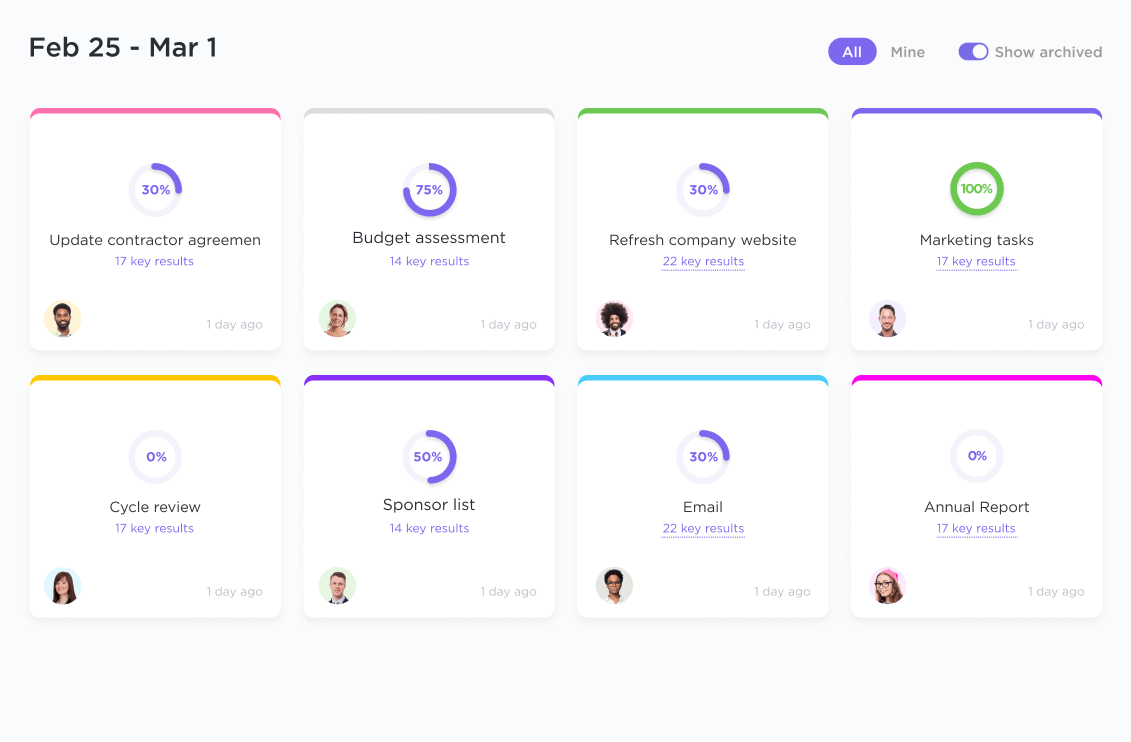
Now here’s where ClickUp Goals makes things effortless. You can define goals inside ClickUp, assign owners for accountability, and set deadlines.
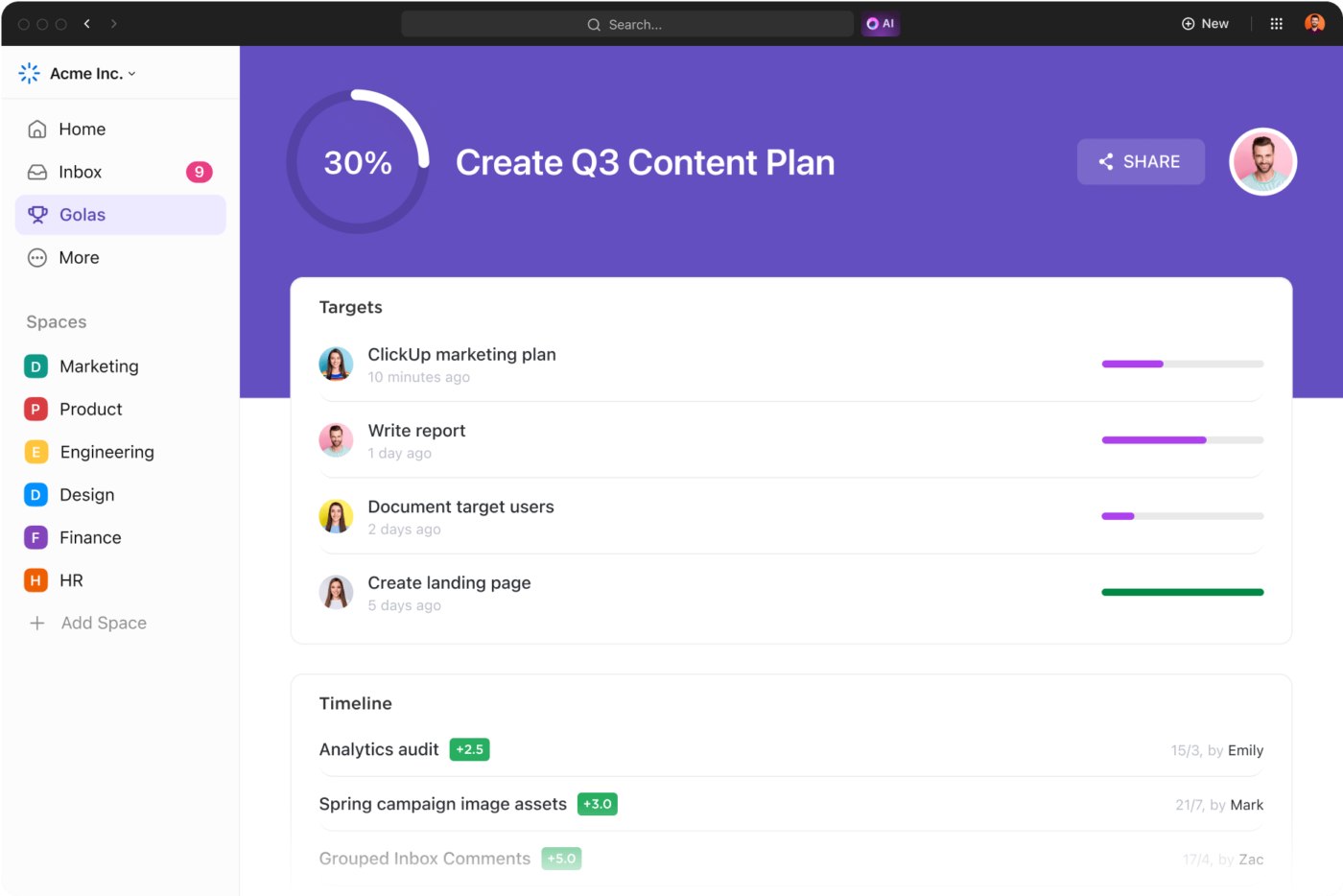
Even better, as a part of your project management strategy, break goals into targets using different formats- task-based, number-based, monetary, or true/false. This will depend on how you plan to measure them. With ClickUp as your project management tool, progress updates will happen automatically as linked tasks move forward.
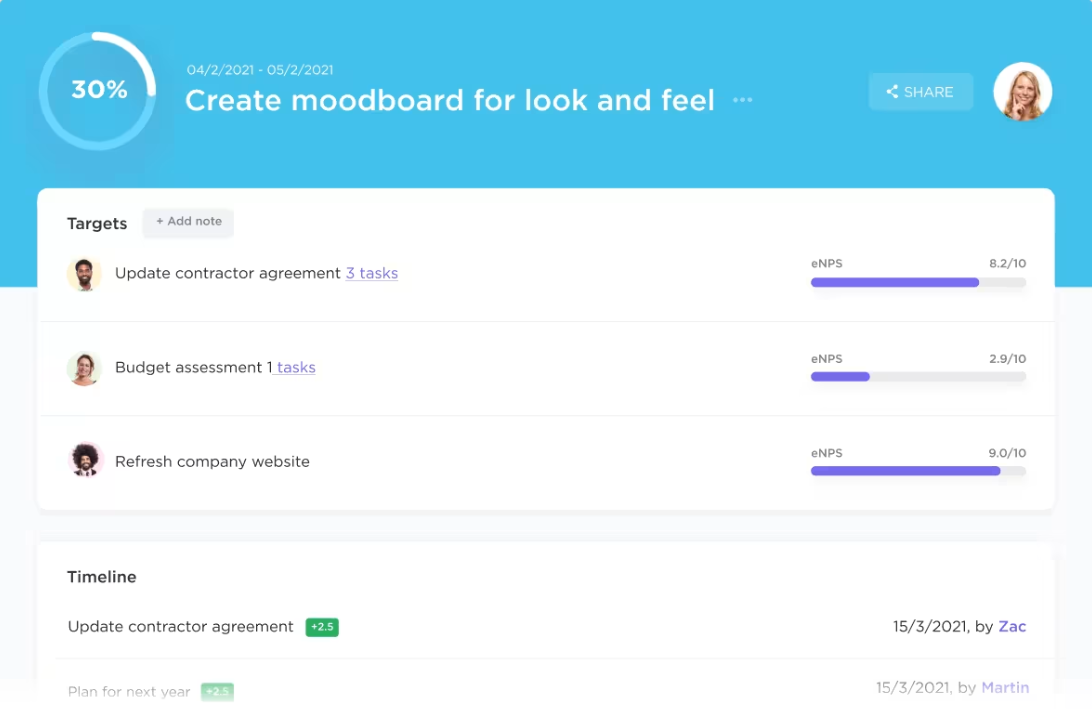
⚡ For example, let’s say a marketing team sets a goal to boost lead conversions by 25% next quarter. Using ClickUp Goals, they track this KPI and link tasks like “A/B test CTAs” or “Optimize ad copy.” Progress updates in real-time, helping them quickly spot what’s working and what’s not
If the conversion rate increases as expected, it confirms that you have an effective project management strategy in place. If not, the team knows it’s time to reassess and adjust.
One of the biggest blockers to project efficiency is the inability to streamline processes, especially when teams lack visibility into where time is spent or how resources are being used.
Time tracking helps you measure exactly how long tasks take, identify patterns, and spot inefficiencies. When paired with effective resource planning, you can proactively allocate time, people, and tools where they matter most before issues arise.
Start by encouraging your team to track time daily. Use simple timers or time tracking templates, depending on what works best for you. Then, review reports weekly to spot any patterns, like tasks that regularly take longer than estimated or teammates who are overloaded.
ClickUp makes this easy with its built-in ClickUp Project Time Tracking feature.
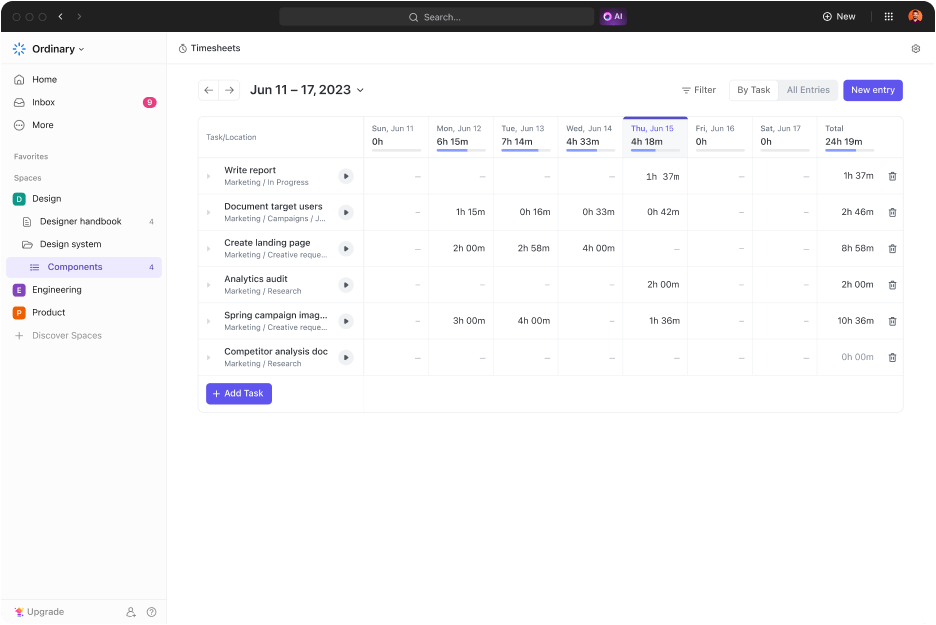
Here’s how:
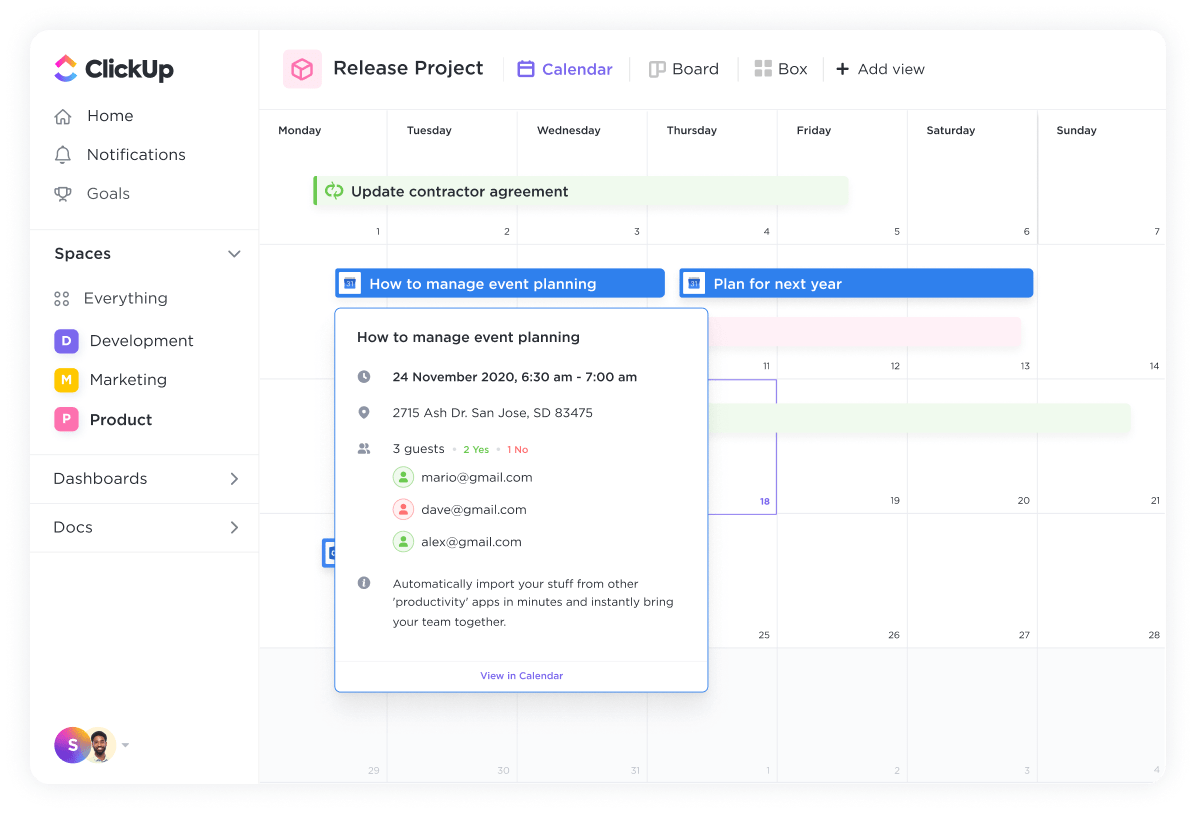
⚡ For example, let’s say a design team is working on a product launch. With ClickUp project time tracking, they can track the time spent on research, wireframing, prototyping, and revisions; each entry is tagged under its respective phase.
If they realize that prototyping consistently overshoots the estimated time, they can investigate whether it’s a process issue or a resource management gap and plan future sprints accordingly.
Every team has tasks they repeat: launching a campaign, onboarding a client, delivering a project. But when each one starts from scratch, small gaps turn into big setbacks.
One of the best ways to bring this into action is by creating project templates. These templates act like blueprints for standardization and continuous improvement. They capture your best-performing workflows and let you reuse them for future projects without having to start over every time.
ClickUp makes this super simple with its range of project templates, each one designed to solve a specific project need. At the heart of this is the ClickUp Create Process Efficiently Template.
It helps you define every step of your internal processes, from planning and approvals to handoffs and delivery, across the project lifecycle. You can lay out tasks, assign owners, set deadlines, and map dependencies in a single structured view. Whether documenting a client onboarding process or building a QA checklist, this template makes repeatability effortless.
For more complex projects and workflows, you can also use the ClickUp Project Management Template, which provides a ready-made framework for managing large projects with multiple stakeholders.
It includes status stages such as ‘On Hold’, ‘In Progress’, or ‘Blocked’ and supports different views —Gantt, Kanban, and Calendar —so you can manage progress in your preferred style.
The ClickUp Time Management Schedule Template clearly visualizes individual and team schedules, ensuring both realistic and trackable deadlines.
And when you’re dealing with deliverables spread across multiple timelines or teams, the ClickUp Project Deliverables Template helps you track progress and accountability without getting lost in the details.
By leveraging these templates, you bring structure and repeatability to every project, and your team builds momentum from day one.
If your team is spread across time zones, you know how energy-draining calls can be.
That’s where asynchronous (async) communication steps in. It allows people to share updates, give feedback, and collaborate at their own pace without waiting for the next call.
For this, you need tools that keep communication structured, searchable, and connected to the actual work. ClickUp gives you all of that (and more) built right in ClickUp Chat.

Unlike traditional messaging tools that live outside your project space, Chat in ClickUp is embedded directly within your workflows. You can create dedicated chat views inside a specific task list, folder, or space so conversations stay relevant to the work.
📮 ClickUp Insight: A typical knowledge worker has to connect with 6 people on average to get work done. This means reaching out to 6 core connections on a daily basis to gather essential context, align on priorities, and move projects forward.
The struggle is real—constant follow-ups, version confusion, and visibility black holes erode team productivity. A centralized platform like ClickUp, with Connected Search and AI Knowledge Manager, tackles this by making context instantly available at your fingertips.
When you need more focused conversations, ClickUp Comments are your time saver. You can leave contextual comments on specific tasks, docs, or subtasks.
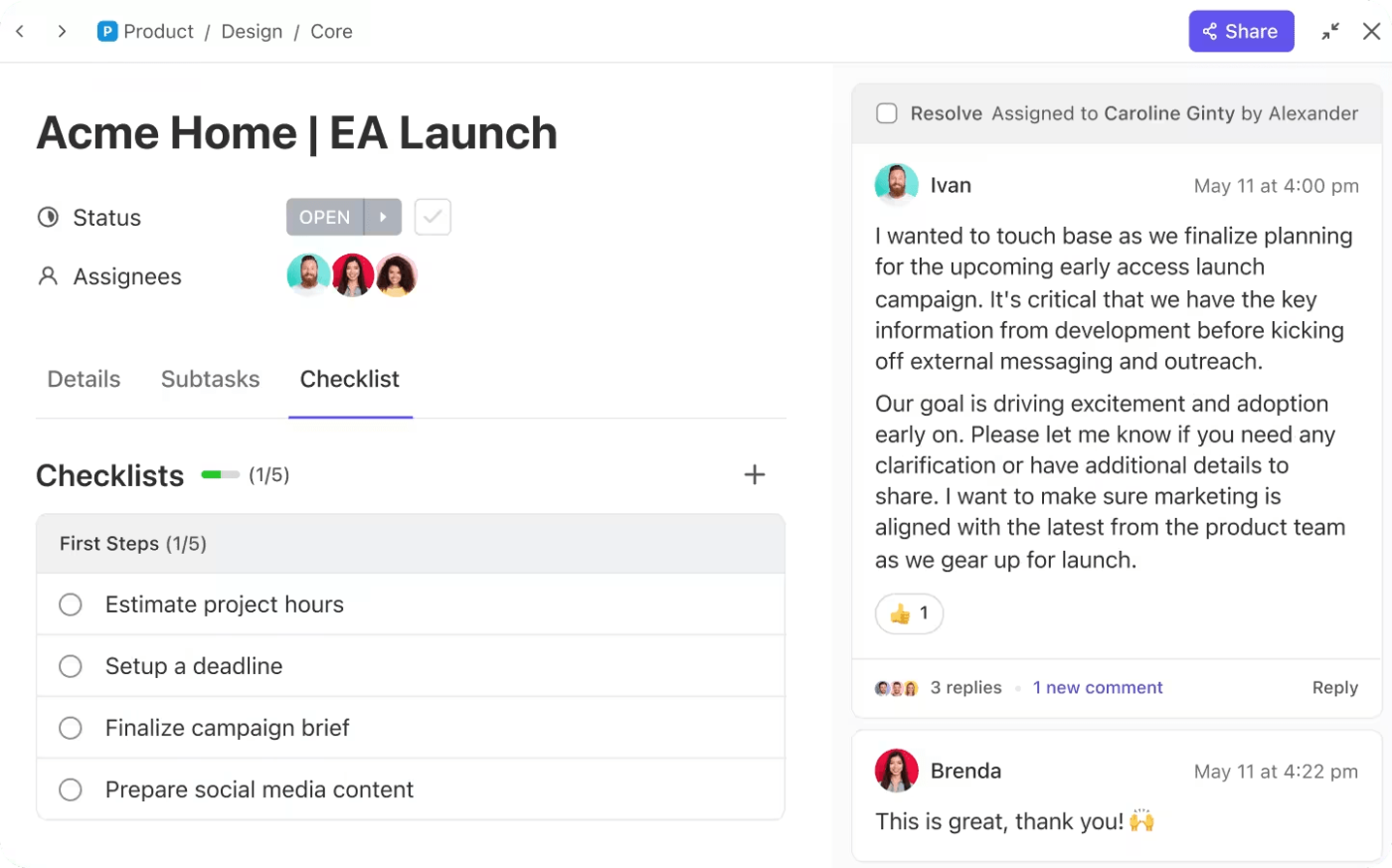
And with ClickUp @mentions, you can nudge the right person without broadcasting to everyone.
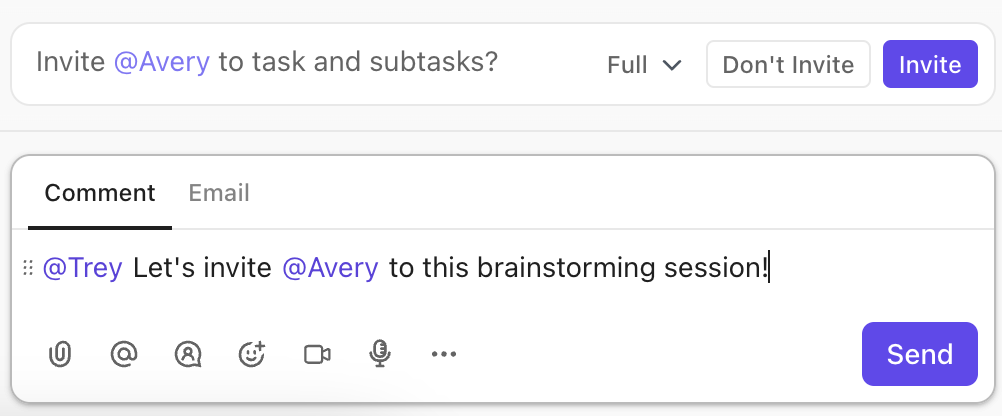
The best part is that comments can be converted into action items instantly, so feedback doesn’t just sit there; it turns into done.
📮 ClickUp Insight: 48% of employees say hybrid work is best for work-life balance. Yet, with 50% still working mostly in the office, staying aligned across locations can be a challenge.
But ClickUp is built for all kinds of teams: remote, hybrid, async, and everything in between.
With ClickUp Chat & Assigned Comments, teams can quickly share updates, give feedback, and turn discussions into action—without endless meetings. Collaborate in real time via ClickUp Docs and ClickUp Whiteboards, assign tasks directly from comments, and keep everyone on the same page no matter where they work from!
💫 Real Results: STANLEY Security saw an 80% increase in teamwork satisfaction thanks to ClickUp’s seamless collaboration tools.
That said, not everything is best explained in writing. And for that, you have ClickUp Clips. Clips let you quickly record your screen with voiceover and share it instantly. Just hit record, walk through your thought process, and send it off.
Your teammate can watch (and rewatch) it on their own schedule. It’s a time-saving win for async standups, product reviews, and onboarding guides.
Documentation is another significant player in asynchronous work, and ClickUp Docs integrates it into your project system. You can create, edit, and collaborate on docs in real-time or async.
You can leave comments on specific lines, assign action items directly from the text, and keep your docs linked to relevant tasks.

⚡ Template Archive: Boost your daily output with these productivity templates built to help you stay organized, manage tasks better, and get more done in less time
Repetitive tasks like setting task statuses, assigning team members, or sending weekly reports quietly eat away at your team’s productivity and creative capacity. That’s why eliminating busywork through automation is a strategic move.
Some common examples of automatable tasks include:
ClickUp helps streamline workflow automation with a powerful suite of automation tools. ClickUp Automations lets you build rule-based workflows using Triggers (like a status change), Conditions (such as task type or assignee), and Actions (like changing lists, updating fields, or notifying users).
These rules can be customized to fit your team’s exact needs. For example, you can set a rule where every time a “Design Request” task is marked “Ready,” it’s automatically moved to the Design List and assigned to a specific team member.
And then comes ClickUp Brain, which adds an intelligent layer to this automation game. It acts like an AI sidekick that handles mundane yet critical tasks like:
To give you a practical example, let’s say you want to create a brief for a new product launch project. Instead of building it manually, you can simply ask:
“Create a project brief for a product launch including key deliverables, timeline, assigned team roles, and risk assumptions.”

ClickUp Brain will generate a full draft of the brief, complete with structured sections and relevant content, ready for review and customization.
With these capabilities, you’re actually upgrading how your team collaborates, communicates, and moves projects forward without burnout or bottlenecks.
✨ Bonus: ClickUp Brain users can choose from multiple external AI models, including GPT-4o, Claude, and Gemini for various writing, reasoning, and coding tasks, right from within their ClickUp platform! Maximize project efficiency with the AI model of your choice with ClickUp!

📚 Also Read: How to Use AI for Productivity (Use Cases & Tools)
Fostering accountability begins by ensuring that everyone is clear about their responsibilities, deadlines, and what constitutes success. These are foundational project management skills that reduce confusion, limit delays, and encourage a stronger sense of ownership and follow-through.
ClickUp Task Management features make it simple to assign every task to a specific owner with a defined due date, priority level, and even time estimate.
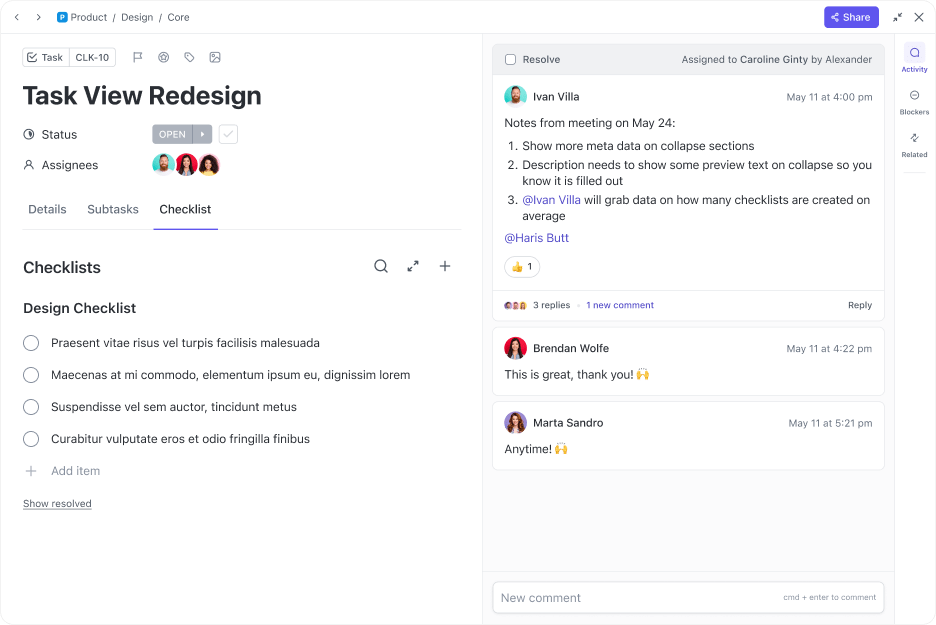
You can break big initiatives into manageable subtasks using a clear work breakdown structure, assign them to different team members, and link dependencies so no one starts work without the right input. Teams can also set recurring tasks, attach project briefs, leave contextual comments, and track progress.
Deadlines aren’t just static dates either. ClickUp lets you:
Most importantly, everything updates in real time. When a task is delayed, reassigned, or completed, ClickUp reflects that instantly, so everyone stays on the same page. You can even enable task watchers, so key stakeholders receive updates without being directly assigned.
🧠 Fun Fact: When more people join a group task, each individual actually contributes less effort—a phenomenon known as the Ringelmann effect, where group members rely on others to pull the load.
📚 Also Read: Top Task Automation Software to Boost Productivity
Every project, no matter how well-planned, offers learning opportunities throughout the project lifecycle. Teams encounter unexpected roadblocks, discover workarounds, and evolve their workflows over time. That’s where regular retrospectives become important.
A retrospective is a recurring team ritual, usually conducted at the end of a sprint, project phase, or milestone, where teams evaluate their performance in a safe, honest, and actionable way. It also strengthens team dynamics and drives continuous improvement within your team.
To make retrospectives effective, it helps to:
But while talking things through is valuable, capturing feedback systematically makes a real difference. With tools like ClickUp Forms and the ClickUp Feedback Form Template, you can turn these recurring discussions into a scalable and trackable system.
ClickUp Forms enable you to design your retrospective questionnaire with dropdowns, rating scales, checkboxes, and long-form text inputs. You can automatically convert responses into tasks for follow-up, assign action items, and revisit feedback during your next review to see what’s improved.

And if you want to skip the setup, ClickUp’s Feedback Form Template gets you started in minutes; just customize the questions, share the link, and you’re good to go.
All responses feed directly into ClickUp as tasks or comments, enabling quick follow-up, prioritization, and visibility. You can even automate reminders for feedback after every sprint using ClickUp Automations, making the entire retrospective cycle hands-free.
📚 Also Read: Project Management Hacks to Boost Productivity
Improving project efficiency is only half the battle. Knowing how to measure it will drive continuous growth. Here’s how to do it effectively.
One of the simplest yet most effective ways to measure project efficiency is by using the classic formula:
Project Efficiency = Planned Output / Actual Resources Used
This gives you a direct ratio of how much was achieved compared to what was invested, whether that’s time, budget, or manpower.
The closer your ratio is to 1 (or higher), the more efficient your project execution has been. This metric is especially useful for identifying resource bottlenecks and fine-tuning future planning.
Numbers tell the real story of your project’s performance. Beyond just using a formula, it’s essential to track specific project metrics that give you a clearer picture of project efficiency and support better project time management. Some of the most insightful ones include:
Monitoring these metrics consistently helps you identify areas that are slowing you down, develop mitigation strategies early, and adjust your approach before issues pile up. It also plays a vital role in resource management, helping you allocate time, tools, and talent more effectively for each project phase.
👀 Did You Know? According to a survey by PMI, Professionals with high business acumen used 9.1 success metrics per project on average, compared to 6.3 used by others, indicating a broader, value-driven approach to performance tracking
Measuring project efficiency is a continuous process. To make informed decisions and keep everything on track, you need real-time visibility into what’s working and what’s falling behind. It’s also key for ongoing project evaluation, helping you adjust before issues escalate.
That’s where you need project dashboards. These tools bring all your key metrics, like task completion rates, resource utilization, time logged, KPIs, and budget tracking, into one visual view.
ClickUp makes this easier with its powerful ClickUp Dashboards and Analytics capabilities. You can:
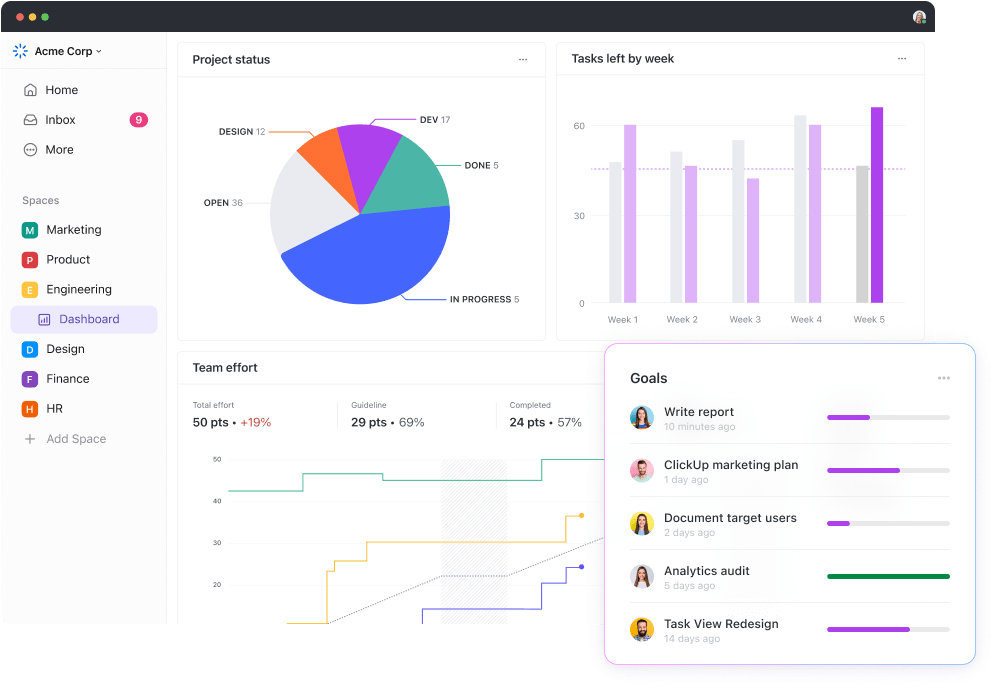
All of this plays a vital role in project management process improvement. And since it’s all centralized in ClickUp, collaboration becomes easier and reporting becomes faster.
Improving project efficiency isn’t about doing more. It’s about doing what matters- better and faster. With the right tools, strategies, and a mindset for proactive risk management, you can plan smarter, reduce chaos, and help your team work with clarity and focus to complete every project successfully.
ClickUp brings everything under one roof: goal tracking, time management, templates, automation, dashboards, and more. So instead of jumping between different project management tools and meetings, you spend more time moving work forward.
Start small. Pick one or two strategies from this guide and try them out in your next project. With ClickUp, even small changes can lead to big improvements and help you achieve project goals with less friction.
Sign up for ClickUp today!
© 2025 ClickUp